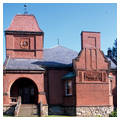With its town common, open fields, stone walls, and orchards, Lincoln Center Historic District provides the Greater Boston area's closest approximation of rural village life of the eighteenth and nineteenth centuries. Founded in 1754, Lincoln grew slowly during the eighteenth century along five roads that radiate from the village center. The town Poor House (7 Old Lexington Road), built in 1785 (and later expanded as the Hunt-Rice Tavern in the 1830s), symbolizes the early development of the town.
The first period of true prosperity occurred in the 1830s, when many fine public and private buildings were erected. Unitarians broke away from the Congregational Church in 1842 and commissioned Reuben Smith to construct the Ionic temple-form White Church (4 Bedford Road) with central tower and steeple. Similar in scale and pretension are the Town Hall, built by Nathaniel Hosmer in 1848 (moved in 1892 to 25 Lincoln Road), and the Asa White House (c. 1854–1856, 29 Sandy Pond Road) with its monumental Doric portico.
The arrival of the Boston, Concord & Fitchburg Railroad at South Lincoln in 1844 permanently shifted the commercial core to that area and heralded the arrival of wealthy commuters, such as George G. Tarbell, who built his mansard-roofed mansion (34 Bedford Road) in 1869. Other professional men followed, including architect George F. Newton, whose stuccoed Georgian Revival house of 1898 stands at 29 Trapelo Road, and stockbroker John H. Pierce, who erected a copy in 1900 of the Vassall-Craigie-Longfellow House (BS7) of 1759 in Cambridge at 17
Boston businessmen funded the construction of new public buildings. Tarbell financed the building of the Romanesque Revival Lincoln Public Library, designed by William Gibbons Preston in 1883–1884, with an award-wining postmodern addition by Graham Gund Architects in 1989. George F. Bemis generously contributed to the construction of both the Romanesque Revival Congregational Church (14 Bedford Road) in 1891 by H. M. Francis and a new cupola-topped red brick and terra-cotta Georgian Revival Town Hall (15 Bedford Road) in 1892 by H. Langford Warren.


















